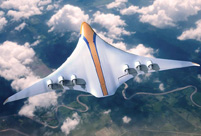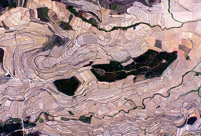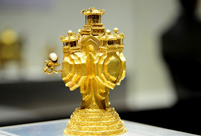


Artist's conception of the Chandra x-ray observatory, that collected the data on Jupiter and its Northern Lights used in this study. The impact of solar storms on Jupiter's aurora was tracked by monitoring the X-rays emitted during two 11-hour observations in October 2011
The impact of solar storms on Jupiter's aurora was tracked by monitoring the X-rays emitted during two 11-hour observations in October 2011, when an interplanetary coronal mass ejection (CME) was predicted to reach the planet from the sun.
Interplanetary CMEs are massive bursts of gas and magnetic field that arises from the solar corona and is released into the solar wind.
'In 2000, one of the most surprising findings was a bright 'hot spot' of x-rays in the aurora which rotated with the planet,' added Mr Dunn.
'It pulsed with bursts of x-rays every 45 minutes, like a planetary lighthouse. When the solar storm arrived in 2011, we saw that the hot spot pulsed more rapidly, brightening every 26 minutes.
'We're not sure what causes this increase in speed but, because it quickens during the storm, we think the pulsations are also connected to the solar wind, as well as the bright new aurora.'
The scientists used the data collected to build a spherical image to pinpoint the source of the x-ray activity and identify areas to investigate further at different time points.

There are two types of aurora on Earth - aurora borealis, or 'dawn of the north', and aurora australis, 'dawn of the south. They are caused when electrically charged particles from the sun enter the Earth's atmosphere. These so-called geomagnetic storms occur when a solar wind hits the Earth's magnetic field
These findings will complement Nasa's Juno mission arriving at Jupiter this summer.
The mission aims to understand the relationship between the two biggest structures in the solar system - the region of space controlled by Jupiter's magnetic field and the region controlled by the solar wind.
As part of the mission, Juno will investigate Jupiter's relationship with the sun and the solar wind by studying its magnetic field, magnetosphere and aurora. The UCL team hope to find out how the X-rays form by collecting complementary data using the European Space Agency's X-ray space observatory, XMM-Newton, and NASA's Chandra X-ray observatory.
'We've only ever seen the day-side aurora of Jupiter though (because when you look from Earth that's all you can see,' Mr Dunn told MailOnline.
'This means that we have no idea what is happening on the night-side. Juno will provide the first opportunity to see the aurora on Jupiter's night-side. As to what it will look like, your guess is probably as good as mine. This is sort of a strange idea though, because at Earth we're used to seeing the Northern lights at night time.'
'Comparing new findings from Jupiter with what is already known for Earth will help explain how space weather is driven by the solar wind interacting with Earth's magnetosphere,' said Professor Graziella Branduardi-Raymont, from UCL's Mullard Space Science Laboratory.
'New insights into how Jupiter's atmosphere is influenced by the Sun will help us characterise the atmospheres of exoplanets, giving us clues about whether a planet is likely to support life as we know it.'
Another study out today, led by Tomoki Kimura from the Japan Aerospace Exploration Agency (JAXA) and co-authored by the UCL researchers, reports that the X-ray aurora responds to quieter 'gusts' of solar wind, deepening this connection between Jupiter and the solar wind.
 |
 Thai most beautiful transgender Nong Poy release new photos
Thai most beautiful transgender Nong Poy release new photos Now and then photos of Shanghai Jiaotong University
Now and then photos of Shanghai Jiaotong University Is this what air travel will look like in 2050?
Is this what air travel will look like in 2050? Aerial view of watermelon terraces in S China's Baise
Aerial view of watermelon terraces in S China's Baise Traditional wedding of a post-80s Tibetan couple
Traditional wedding of a post-80s Tibetan couple Models in cheongsams present classical oriental beauty
Models in cheongsams present classical oriental beauty Second commissioned C28A corvette made by China enters Algerian Navy
Second commissioned C28A corvette made by China enters Algerian Navy Intoxicating Wuyuan in spring
Intoxicating Wuyuan in spring Gold and silver wares of Qing Dynasty exhibited in Shenyang Imperial Palace
Gold and silver wares of Qing Dynasty exhibited in Shenyang Imperial Palace Top 20 hottest women in the world in 2014
Top 20 hottest women in the world in 2014 Top 10 hardest languages to learn
Top 10 hardest languages to learn 10 Chinese female stars with most beautiful faces
10 Chinese female stars with most beautiful faces China’s Top 10 Unique Bridges, Highways and Roads
China’s Top 10 Unique Bridges, Highways and Roads Brussels attacks expose vulnerable Europe
Brussels attacks expose vulnerable Europe Govt mulls ways to curb forex speculation
Govt mulls ways to curb forex speculation Without proper pensions, 46 mln elderly migrant workers cannot retire
Without proper pensions, 46 mln elderly migrant workers cannot retire Countries across the world have begun pasting graphic images on their cigarettes – why China isn’t likely to follow suit
Countries across the world have begun pasting graphic images on their cigarettes – why China isn’t likely to follow suitDay|Week